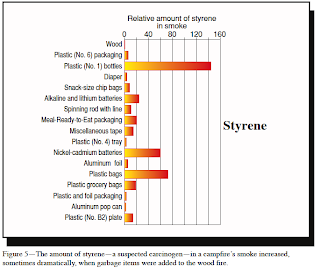News & Updates
What’s In Your Campfire?


 In 2004 the USDA Missoula Technology and Development Center, a USDA Forest Service research facility, studied the toxins released from various kinds of trash when burned in a campfire. The researchers burned everything from plastic bags to batteries to baby diapers. Over 27 different items were burned, and both the gas emissions and ash content were analyzed. The results were scary at best. Numerous chemicals, most of which are known carcinogens, were released from the burning trash. Lead, xylene and benzene were just a few of the many toxins released from burning trash.
In 2004 the USDA Missoula Technology and Development Center, a USDA Forest Service research facility, studied the toxins released from various kinds of trash when burned in a campfire. The researchers burned everything from plastic bags to batteries to baby diapers. Over 27 different items were burned, and both the gas emissions and ash content were analyzed. The results were scary at best. Numerous chemicals, most of which are known carcinogens, were released from the burning trash. Lead, xylene and benzene were just a few of the many toxins released from burning trash.

 Interestingly enough, the study showed that even campfires that just burn wood released a significant amount of air pollutants. The addition of garbage greatly increased the pollutants and toxins released. Ash left over from a fire that contained only wood primarily consisted of nontoxic elements. However, when garbage was burned, toxic compounds in the ash were greatly increased. As a result, the researchers recommend that anyone handling campfire ash wear protective gloves. Furthermore, they recommended that all trash, regardless of what it is, be packed out and properly disposed of in a trash receptacle.
Interestingly enough, the study showed that even campfires that just burn wood released a significant amount of air pollutants. The addition of garbage greatly increased the pollutants and toxins released. Ash left over from a fire that contained only wood primarily consisted of nontoxic elements. However, when garbage was burned, toxic compounds in the ash were greatly increased. As a result, the researchers recommend that anyone handling campfire ash wear protective gloves. Furthermore, they recommended that all trash, regardless of what it is, be packed out and properly disposed of in a trash receptacle.
To view the full study, visit: http://air.ky.gov/SiteCollectionDocuments/WhatsBurninginYourCampfire_Article.pdf
Let’s protect and enjoy our natural world together
Get the latest in Leave No Trace eNews in your inbox so you can stay informed and involved.
